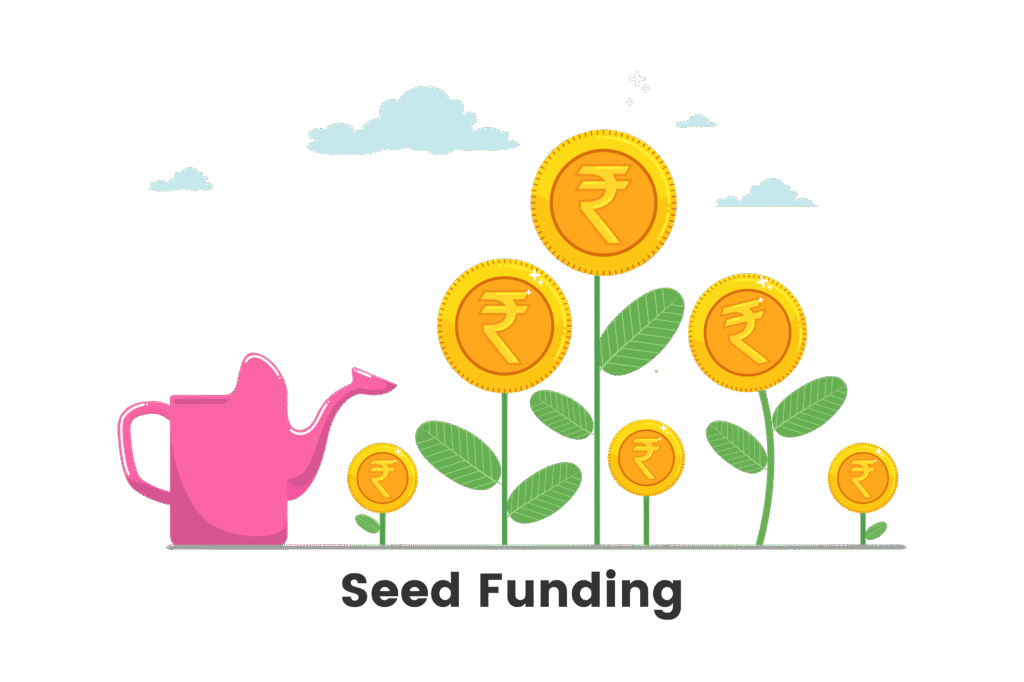Seed funding is a startup’s first institutional capital to kickstart its journey from idea to reality. It provides the resources to build a prototype or MVP, validate the concept, assemble a team, and gain early traction. For example, Carta (Apr 2025) defines seed funding as “the initial capital an early-stage startup raises to reach the next stage of growth,” typically coming from angels, friends/family, incubators, or early-stage VCs. This infusion of cash and mentorship is often make-or-break: without enough funding, startups can struggle with hiring, product development, or market testing. Indeed, industry data warn that ~98% of startups face catastrophic setbacks in their first year and fewer than half survive to their fifth anniversary, underscoring how critical early support is. This comprehensive guide will explain seed funding, how it works (especially in India’s unique ecosystem), and how you, as a founder, can prepare, pitch, and close a seed round.
1. Introduction to Seed Funding
What is Seed Funding?

Seed funding (or “seed capital”) is the first official round of investment a startup raises after any bootstrapping or friends-and-family funding. It’s used to transform a nascent idea into a viable business. At this stage, startups often have a concept, a prototype or early product, and a founding team. In exchange for funding, investors receive equity or convertible securities. Seed investors are typically willing to take very high risks in hopes of outsized returns; for example, Carta notes that seed investors such as angel investors, early-stage VCs, or accelerators expect high potential gains given the risk of loss. Seed funds are typically smaller than later rounds, but they are vital for covering costs like R&D, hiring, marketing, and operations to hit key milestones.
Importance of Seed Funding for Startups
Seed funding is crucial because it bridges the gap between an idea and a scalable venture. It enables startups to:
- Develop the product/MVP: Hire developers or engineers, build prototypes, or refine the product based on user feedback. Early capital turns a concept into something tangible.
- Build a team and operations: Fund co-founders’ salaries, hire first employees or consultants, and set up basic operations (office space, tools, etc.).
- Validate the market: Test the product with early customers, iterate on the business model, and gather data to prove a market need.
- Enhance credibility: Outside investors can signal validation to customers, future investors, and recruits, making it easier to raise subsequent rounds or land key partnerships.
- Unlock further funding: Achieving seed milestones (e.g. product-market fit or growth metrics) is often required before attracting larger Series A investors.
Without seed capital, many startups stall at the idea stage. In India, supportive programs recognise this: for example, investors like Info Edge poured as little as ₹4.7 crore into Zomato at the seed stage (2010), a move that ultimately yielded a 1,000× return. This early backing can turn founders into major job creators and unicorn builders. Seed funding is the launching pad—it gives startups room to breathe and learn before taking on the much larger sums of Series A and beyond.
2. The Indian Startup Ecosystem

India’s startup ecosystem has exploded in the last decade. As of early 2025, India boasts over 1.59 lakh DPIIT-recognised startups, making it the world’s 3rd-largest startup base. This is a massive jump from just ~500 in 2016. Major hubs like Bengaluru, Mumbai, and Delhi-NCR lead the charge, but Tier-II/III cities increasingly contribute over 50% of new startups from smaller towns. Across sectors (fintech, edtech, healthtech, e-commerce, deeptech, etc.), Indian startups are solving local problems at scale. For instance, the founders of Zomato, Nykaa, Ola and many others began with small seed rounds and have grown into billion-dollar companies.
This ecosystem growth is reflected in funding trends. After a brief lull post-2021, 2024 saw a rebound in investment activity. Indian startups raised roughly $12 billion in 2024, about a 20% increase over 2023. The number of deals also ticked up (~993 in 2024, up ~11% year-on-year). Early-stage rounds fared particularly well: Inc42 reports that seed and growth-stage funding jumped ~31% in 2024. Correspondingly, new investment funds also saw record launches, 81 new funds totalling $8.7 billion were set up in 2024 (a 55% jump over 2023).
Chart: New startup funds raised in India (2024) by sector. Fintech-led funding, followed by consumer and deeptech (sources: Inc42).
Beyond private funding, India’s government has rolled out numerous initiatives to support startups, particularly at the seed stage. Key programs include:
- Startup India (DPIIT): The flagship initiative (launched in 2016) simplifies regulatory compliance, offers tax exemptions, and provides a ₹10,000 crore Fund-of-Funds (FFS) to back early-stage venture funds. This means the government co-invests in VC funds, amplifying private funding for startups.
- Startup India Seed Fund Scheme (SISFS): Launched in 2021 with a ₹945 crore corpus over 4 years, the SISFS directly supports startups through incubators. Under SISFS, an Expert Advisory Committee grants up to ₹ five crore each to about 300 incubators. These incubators, in turn, disburse funds to startups typically up to ₹20 lakh per startup for proof-of-concept, prototyping, and trials, and up to ₹50 lakh per startup for market entry or scaling, often via convertible debt. By December 2024, over 213 incubators were approved under SISFS, and it’s expected to benefit ~3,600 startups. Startups can apply to participating incubators online (up to 3 at once) during year-round calls.
- Other support schemes include programs like Atal Innovation Mission (AIM), which funds tech incubators, and agencies like SIDBI, which run state-level startup seed funds. Additionally, missions like Nidhi Prayas and STPI provide grants and coworking support to early-stage teams.
These measures and mentorship from accelerators and angel networks create a dynamic environment for a seed funding startup in India. Founders have access to formal funding, plus a growing pool of angel investors, incubators, and entrepreneurial networks. Understanding this ecosystem is the first step in successfully raising your seed round.
3. Understanding Seed Funding
Sources of Seed Funding

Seed funding can come from many sources. Every day, seed investors include:
- Angel Investors & Networks: High-net-worth individuals (often experienced entrepreneurs) who invest personal funds at very early stages. In India, large angel networks like Indian Angel Network (IAN) or platforms like LetsVenture have financed hundreds of startups. Angels may invest solo or as syndicates and often provide mentoring as well.
- Friends and Family: Early founders frequently tap personal connections for initial capital. These rounds are informal and usually based on trust, but they can quickly give a startup the runway to build something concrete.
- Seed Funds and Early-Stage VCs are specialised funds focused on seed/pre-seed rounds. Examples in India include Blume Ventures and 100X.VC, Unicorn India Ventures, and venture debt funds like Stride Ventures. Many larger VCs also have seed programs (e.g. Sequoia Surge, Accel India’s seed fund). They often participate after angels or hold small dedicated funds.
- Incubators & Accelerators: Programs like Y Combinator (global), Axilor Ventures (India), or IIT/IIIT incubators often provide a small investment (in exchange for equity) plus mentoring and workspace. For example, GSF Accelerator and Nasscom 10,000 Startups incubator have backed many early-stage teams.
- Crowdfunding: Platforms (e.g. Kickstarter or Indian crowdfunding sites) allow raising small sums from many supporters. This is less common for tech startups, but creative or consumer products sometimes use it.
- Government Grants & Schemes: As noted, schemes like SISFS provide grants/loans via incubators. These funds don’t take equity, making them attractive. Research grants (DBT, MeitY, etc.) for tech projects are also available.
- Corporate Innovation Funds: Some big companies run startup programs, offering small seed investments to early-stage ventures relevant to their industry.
Whatever the source, most seed funding comes with equity or similar promises of future equity. As Carta notes, early-stage investors “put up their money… for potentially high returns…receiving equity or convertible securities in exchange”.
How Seed Funding Works

The startup usually sells part of its equity (shares) to investors in a seed round. The startup’s pre-money valuation plus the new investment determines the post-money valuation, and the percentage given away is simply (investment ÷ post-money valuation). For example, a guide for Indian startups suggests a typical early round might be ₹2-3 crore for 10-15% of the company, implying a ₹15-20 crore valuation. (Alternatively, one can do an unpriced round using convertible notes or SAFEs instead of initially setting a fixed valuation.)
Many seed rounds today use convertible instruments (notes or SAFEs) rather than priced equity. In a priced round, you sell shares at a fixed price. In a convertible round, you issue a note or SAFE that will convert into equity at the next round’s valuation. SAFE notes in particular have become popular because they are fast and straightforward: they are not debt (no interest or maturity) and just entitle the investor to future equity. Convertible notes are debt that converts into equity upon a qualifying round. For instance, Carta notes that “for most companies, seed-stage financing is on convertible instruments because it’s usually faster and easier”. (Whether priced or convertible, these terms will be negotiated based on your startup’s traction and investor negotiation.)
Typical deal sizes at the seed stage vary by region and sector. In India, tech seed rounds often range from tens of lakhs to a few crores of rupees. A Blume Ventures report notes seed financing saw a drop in the number of deals but an increase in average size in recent years. For context, global data around 2021-22 showed average seed rounds at roughly $0.5$1.1 million (~₹48 crore). Local guidance suggests pre-seed raises of ₹23 Cr and seed rounds of ₹310 Cr are standard for tech startups. Of course, these are just benchmarks. Some startups raise less (if capital-light), and others raise more if competition for deals is high.
Entrepreneurs should carefully plan the round in all cases: how much capital is needed to reach the following milestones, and how much equity founders are comfortable giving up. As a rule, keeping dilution moderate (often ≤15% at pre-seed/seed) is wise, since you’ll need reserves for the future.
4. Seed Funding vs. Venture Capital

It’s essential to distinguish seed funding from later-stage venture capital (VC). Here are some key differences:
- Stage of Company: Seed funding happens at the idea/validation stage. Founders may have a prototype or initial users, but little revenue. Venture capital usually refers to Series A/B rounds when the company has demonstrated product-market fit and some growth. VCs expect more traction and lower risk than seed investors.
- Amount Raised: Seed rounds are typically smaller (in India, often ₹210 Cr, as discussed). VCs invest much larger sums (tens to hundreds of crores, depending on the series). Seed investment might be $50k$500k, whereas Series A could be $ 2 m$10 m or more.
- Valuation & Dilution: Seed valuations are lower (₹1050 Cr), so seed investments for a given stake cost less. VC rounds feature higher valuations (₹50 Cr+), so for the same stake, you invest more money. Early investors take more risk (so they often want more equity for the amount).
- Investor Profile: Seed investors are often angels, accelerators, or micro-funds. They may invest autonomously or in small syndicates. VCs are typically institutional funds with partners, processes, and LP commitments, investing from larger pools of capital.
- Risk and Expectations: Seed investors accept that many startups fail. They look for potential—a great team or technology. VCs, by contrast, invest when there’s evidence of traction; they expect viable business models. VCs also often anticipate multiple exits to justify their larger bets.
- Dilution Preferences: VCs generally take minority stakes (often 20-30% at Series A), but because rounds are large, founders can still keep significant equity. Seed investors’ stakes vary; some take ~10% (in safe rounds) to 20% (if priced) for small sums.
- Terms and Control: Series A+ VCs often require more control (board seats, stronger terms). Seed deals may be founder-friendly, especially as SAFEs or simple convertible notes with limited terms. However, every deal is negotiable: even seed deals can have terms like liquidation preference or founder vesting.
- Timeline to Raise: Seed rounds can be quicker (weeks to a few months) due to smaller deals, though they still require due diligence. Series A VC rounds often take longer (36+ months) with formal term sheets and term negotiation.
When to choose Seed vs. VC: Most startups start with seed funding to build product and market fit. Once you have those (and want to scale), you pursue VC in Series A. If you try to raise VC too early (with no traction), VCs may pass and suggest you get a seed round first. Conversely, if your startup grows fast and needs significant capital for expansion, you may skip smaller seed rounds and raise a bigger Series A directly from VCs. In short, use seed funds for “proof” and early growth, and turn to venture capital when you have proven the concept and need significant growth capital.
5. The Seed Funding Process
Preparing Your Startup for Funding

Before you reach out to investors, get your house in order. Key preparations include:
- Build an MVP or Prototype: Ensure you have a working prototype or MVP. Investors like to see something concrete. (Carta notes that companies are generally “ready” for seed fundraising when they have a product to demo or a user-ready MVP.)
- Solidify Your Team: Most investors invest in teams as much as ideas. Highlight a strong founding team (relevant expertise, commitment, and track record, if any). Advisors or early hires with domain knowledge also help.
- Understand Your Market: Develop a precise market analysis and business model. Know your target customers and competitors, and why your solution is needed. Be prepared to explain the market size and how you’ll capture it.
- Get Early Traction: Any metrics or validation (pilot customers, letters of intent, downloads, etc.) can significantly boost confidence. Even a small early customer or partnership can prove viability.
- Prepare Financials: Build basic financial projections and unit economics. Investors will ask how you plan to spend their money and what milestones it will achieve.
- Create a Compelling Pitch Deck: Develop a concise pitch deck (~1015 slides) that covers the problem, solution, market, product, traction, team, and financial aspects: clarity and storytelling matter. Venture Care, for example, emphasises crafting “compelling business plans and pitch decks” as part of raising funding.
- Define Your Ask: Know exactly how much you want to raise and for what equity/valuation. Consider preparing a priced term sheet and a convertible terms outline in case negotiations lean that way.
Investors often assess startups on consistent criteria: growth potential, team quality, and product uniqueness. Make sure your preparation covers these areas. As the SVB startup insights note, VCs will look at “your growth potential, the strength of your management team, [and] the appeal or uniqueness of your products or services”. Be ready to demonstrate each convincingly.
How Do Startups Get Funding
Raising seed money is part science and part hustle. Here are common pathways:
- Networking and Warm Introductions: Personal networks are gold. Attend startup events, demo days, pitch competitions, and meetups. Talking to mentors, fellow founders, or professors can lead to introductions to angel investors. A warm intro from someone trusted often opens doors faster than cold outreach.
- Angel Investors & Syndicates: Reach out to individual angels or groups like the Indian Angel Network, Mumbai Angels, etc. Some platforms (LetsVenture, AngelList) allow you to pitch your deal to a network of angels online. If you have good traction, some angels or super-angels (e.g., Ratan Tata, Anand Mahindra in India) might be interested, too.
- Startup Accelerators/Incubators: Apply to accelerator programs (e.g. Y Combinator, 500 Startups, Axilor, GSF, T-Hub, etc.). These programs offer seed funding plus mentoring in exchange for equity. Being selected can provide initial funding (often ₹1050 lakh) and multiple demo day opportunities to meet investors.
- Crowdfunding and Competitions: For product startups, crowdfunding campaigns or startup contests can raise early funds and visibility. Winning a business plan competition or hackathon can net you seed capital or vouchers.
- Corporate and University Programs: Some corporations run startup contests (e.g. Infosys Startup Saturday) or corporate VC arms. University incubators (IIT/IIM/BITS) often fund alums or current student startups.
- Direct Pitching: Cold-email VCs or angel groups with a brief pitch and deck. If contacting VCs, target those known to invest at the seed stage (list them out beforehand!). If you only have a concept, focus on angel investors or pre-seed funds—institutional VCs usually insist on product/traction first.
- Government Grants/Loans: Government grants can be available for specific sectors (e.g., biotech, manufacturing). In India, schemes like the SISFS (via incubators) don’t require equity, making them an attractive early source—just apply when incubators open calls.
- Investor Events & Demo Days: Many VC firms and incubators host pitch nights or accelerator demo days, during which startups present to a room of investors. Getting a slot at one of these can lead to direct meetings with multiple investors.
In all cases, the key is meeting potential investors and pitching effectively. Be prepared for many no’s—it often takes meeting dozens of investors to close a round. Keep refining your pitch, building relationships (even if they pass, they may refer you to someone else), and following up diligently.
Negotiating Terms

Once investors show interest, you’ll enter term negotiation. Important terms include:
- Valuation and Equity Stake: The most critical term is your startup’s valuation, which determines how much equity investors receive. As noted, many early rounds target 1015% dilution. For example, raising ₹23 Cr at 1015% dilution implies a ~₹1520 Cr post-money valuation. Strike a balance: a higher valuation means less equity given away, but also higher expectations.
- Equity vs Convertible: Decide if the round is priced (selling shares at a fixed price) or convertible (SAFEs/notes). A convertible note is debt that converts to equity at the next round, whereas a SAFE is not debt and converts to equity (often the most common early instrument). SAFEs typically involve little negotiation beyond a valuation cap or discount. In India, unpriced or SAFE rounds are becoming increasingly common for pre-seed/seed.
- Liquidation Preference specifies who gets paid first in a sale or exit. A 1× non-participating preference is standard (investors get their money back first), while any participation or higher multiple demands are more investor-friendly.
- Anti-dilution and Rights: VCs may ask for anti-dilution protection (to adjust price if future rounds raise money cheaply) and certain investor rights (pro-rata rights, board seats, veto rights on big decisions). At the seed stage, try to minimise onerous terms, though a seasoned attorney should review the term sheet to ensure it’s fair.
- Vesting and Founder Commitments: Founders’ shares are often on a vesting schedule (e.g., 4 years) to ensure commitment. Investors may require this if it is not already set.
- Use of Funds: Investors will usually ask for a budget or plan on how you will spend their money (R&D, marketing, hiring, etc.). Have a clear plan.
Negotiating is always a balance. Remember that term sheets are usually starting points, not final deals. For seed rounds, it’s common to aim for founder-friendly terms, especially with angel/accelerator money. Still, be professional and open. If you’re unsure of terms, seek help (legal and from mentors).
Pro Tip: A good rule of thumb is to raise only what you need for the next ~18 months (to reach the next significant milestone). Raising too little can stall you, but raising too much forces higher dilution and pressure to scale. Work out a realistic use of funds and a burn rate.
6. Top Seed Funding Companies in India

India has many venture firms and investors active at the seed/early stage. Some notable names include:
- Accel India: A prominent global VC. In Jan 2025, Accel announced a $650 million early-stage fund for India/SEA, signalling a continued commitment to young startups. (Accel was the seed/series A investor in companies like Flipkart, Swiggy, Freshworks.)
- Sequoia Capital India (Surge): Sequoia’s program targets seed and pre-Series A. Many top startups (even by the time of Series A) have Surge as their first institutional investor.
- 100X.VC: A micro-VC fund focused on seed-stage. They invest small amounts (₹2550 lakh) into hundreds of deals annually, often via equity.
- Blume Ventures: One of India’s oldest seed funds. Blume has backed 100+ startups since 2010 and often leads rounds of a few crores.
- Indian Angel Network (IAN) / Mumbai Angels / LetsVenture: These angel networks syndicate investments from accredited investors, funding dozens of early-stage deals annually.
- Matrix India / Lightspeed India / Nexus / Chiratae (IDG): These larger VCs also participate in early rounds from time to time, especially for high-potential startups. For example, Lightspeed backed early fintech and consumer startups, and Matrix has seed-stage funds.
- Government & SOCSO: SIDBI’s Fund of Funds for Startups invests in VC funds, which indirectly seed startups. In some states, state-run seed funds (e.g. Kerala Startup Fund) invest directly.
- Accelerators: Y Combinator (global), Samagra Capital, Axilor, GSF, T-Hub: they invest small seed checks into cohorts of startups.
- Others: Newer seed/angel funds like Antler India, Pi Ventures (deeptech/AI focus), Venture Catalysts.
India’s most successful startups almost all began with seed investments. For example, Freshworks (a SaaS unicorn) raised its seed round in 2011 from Accel and later IPO’d on NASDAQ. Zomato’s founders secured a ₹4.7 crore seed cheque from Info Edge in 2010, which later became a 1000× return. Ola began in 2010 with seed capital (from SeedFund and others) and grew into India’s largest mobility unicorn. These stories show how a small seed round can explode into a massive exit. One recent government press release noted, “Companies like Zomato, Nykaa, and Ola showcase India’s shift from job seekers to job creators”, highlighting the power of early backing.
Success Stories (brief examples):
- Zomato: It started as an early seed from Info Edge (2010) and is now a listed company, with early investment turning 1000×.
- Freshworks: Seed from Accel (2011) IPO in 2021 on NASDAQ, market cap ~$ 5 B+.
- Ola: Seed from SeedFund (2010) grew to a unicorn, now valued in the multiple billions.
- Unacademy, Nykaa, and PharmEasy all raised early seed/angel rounds that helped them become leading edtech, e-commerce, and health tech unicorns (mentioned among India’s success stories).
These examples underline the role of seed funding companies (investors) and government schemes in nurturing homegrown unicorns, and identifying and pitching to the right seed investors, whether angel syndicates or specialist funds, is a key step in that journey.
7. Venture Care’s Role in Empowering Startups

At Venture Care, we understand the challenges early startups face. We offer a range of services to guide founders through fundraising and growth. Our team provides business consulting, helping shape your strategy and roadmap; financial advisory, creating robust financial models and valuations; and investor matchmaking, connecting you with potential funders. Our website notes that we deliver “unmatched financial, business, and strategic services” and have been recognised as a trusted startup partner. In practical terms, this means we help startups craft compelling business plans and pitch decks, we “gauge our success by your achievements” and work to “help you secure the funding you need and propel your business forward”.
Venture Care also simplifies the fundraising journey. We specialise in investor outreach: identifying the right investors, arranging introductions, and advising on term negotiation. We’ve earned acclaim for “simplifying fundraising through expert investor outreach and transaction services”. With our guidance, startups can save time and avoid pitfalls, especially given that under 50% of new ventures survive their first five years. We’ve helped 100+ startups close funding rounds (from seed to growth stages), celebrating each client’s success as our own.
For example, startups like AAPAI Technologies (health tech), Babystore (e-commerce), Instrukart (B2B marketplace), and Writesonic (AI software) have worked with us. These companies benefited from our expertise in improving their pitch materials and identifying investors (their logos are featured on our site).
By tailoring our services to each venture, Venture Care aims to ignite transformation, turning visionary ideas into successful, investor-ready companies. In short, we partner with early-stage founders, empowering them with the strategy, connections, and confidence needed to succeed.
Conclusion
Seed funding is the lifeblood of a startup’s initial journey. It provides the runway to turn an idea into a product, the means to build a team, and the credibility to attract further support. In India’s booming startup ecosystem (now the 3rd largest globally with over 1.59 lakh startups), founders have unprecedented access to seed investors and government support schemes (like the Startup India seed fund scheme). However, raising seed capital still requires careful preparation and strategy.
By understanding how seed funding works and the differences between seed vs later funding, founders can choose the right path at the right time. Preparing a solid MVP, pitch deck, and team, and knowing how to negotiate terms, are all key to success. Finally, remember that seed funding is not just money—it often brings expertise, mentorship, and a vote of confidence. As the saying goes, “If you want to go fast, go alone; if you want to go far, go together.” Secure the proper seed funding, and you’ll be well on your way to building the next great Indian startup.












